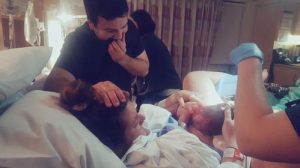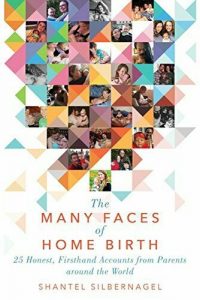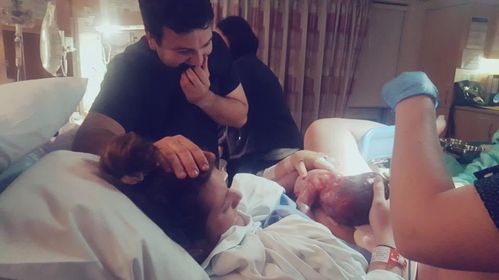“NAÏVE and uneducated… episiotomy… a very traumatic experience” – these are the words used to describe Zoe’s first birth at a private hospital.
Comparatively, her second birth at home, Zoe says she has never felt so supported and safe, and that this experience was “healing, empowering”, and that it has completely changed her as a person.
Everyone’s birth stories are different; from the researching to decision making, to the birth itself. I interviewed Zoe with the aim to hear her account of her two births, first medicalised at a hospital, and second undisturbed at home.
This is Zoe’s unique story, and the thoughts and information she encountered on her journey.
Deciding where to give birth isn’t always an active process for many women, with so many not even considering there may be an option for them outside the public/private hospital choice.
For Zoe, her first experience was just this. The decision was made using her knowledge of birthing as what she had learned from TV, or from friends’ less than positive birth stories.
Zoe had private healthcare provider and as she describes it, she “naively thought private care was ‘better’”. It was what she knew, what her Mum had done, and the idea of ‘a nice big room’ was comforting.
Unfortunately, comforting wasn’t the feeling that came with the interventions of her hospital birth.
Zoe went into hospital to be induced due to a slightly increased blood pressure and being over 40 weeks pregnant. Although knowing it was coming, she didn’t really know what to expect. Having not been well informed of what would happen, she became overwhelmed by the speed with which things progressed. Just 20 minutes after having her waters broken and being started on the Syntocin drip, Zoe was contracting every three minutes.
Although the mother-to-be was not made aware of it at the time, the baby was posterior – facing her front instead of her back – which caused an intense pain in her back which didn’t go away between contractions. Some relief was gained when in the shower on a birth ball with water on her stomach and back, along with gas and air. However, Zoe felt she was really bothering the attending midwife who ignored her request to return to the shower, and kept telling her to lay down, although Zoe’s body did not want to be still.
Four hours after being started on the drip, Zoe was given morphine for pain relief without any explanation of risks involved. A further four hours later, feeling completely out of control, scared and in so much pain in her back, Zoe asked for an epidural. Once the epidural was given, she was able to chat to the beautiful (different) midwife and was able to relax a little.
Finally, after being coached to push due to the effects of the epidural, an episiotomy (an incision made in the perineum) and a forceps delivery, baby Leo was born.

Second time around, however, Zoe knew she didn’t want an experience like her first.
This time, she decided to do some further research. Initially still going back and forth on the decision of whether to birth in a private hospital, public hospital, or at home; it wasn’t until the pregnant mother of one started to listen to positive birth stories from sources outside of her friends, did two hypnobirthing courses, watched home birth videos, and did lots of reading – discovering that her option of private hospital would not release their statistics on intervention which raised big red flags – that the decision for a home birth was made at 28 weeks pregnant.
When deciding to birth at home, Zoe first had to weigh up the risks and benefits. There were definite anxieties about a home birth, mainly from what is often portrayed in the media – that home isn’t a safe place to birth, as well the fear of something going wrong and not being in a hospital.
However, after having heard about a study done in England, which was concluded in 2018, which found results of intended home births of low risk pregnancies to be as safe as intended hospital births, and also having learnt about the “outrageous statistics of intervention in hospitals”, the anxieties eased a lot.
Zoe’s pregnancy was classed as low risk, and so after finding this information, she definitely felt that home was the safest place for her to birth. Also knowing there was a hospital only five minutes’ drive from her home should transfer be required.
When the decision was made to have a home birth, Zoe was lucky enough to gain a spot with the Midwifery Group Practice Program (MGP). These midwives also were able to ease another anxiety by explaining that they would have resuscitation equipment on hand if needed.
When booking in with the MGP midwives, Zoe was given some guidelines and ‘rules.’
For a homebirth to be achieved they were very strict that it should only go ahead if the pregnancy remained very low risk. After Zoe’s first birth, her son Leo had sepsis, and so she had to prove that it wasn’t from a positive Group B Strep, and also that she hadn’t had a haemorrhage. Zoe also was required to sign some birthing in water consent forms and agree that to birth in water she would have her midwife present to check she was further than 7cm dilated.
Other rules were that Zoe had to see her doctor after the 28-week glucose test, and again at 36 weeks for a general pregnancy check-up – blood pressure etc – to make sure she remained medically cleared to birth at home.
As well as giving these guidelines, the MGP midwives were encouraging, and supported Zoe wholeheartedly with her plan for a homebirth. Zoe was able to meet and get to know the women, one of whom would eventually attend the birth of her second child.
When Zoe went into labour this time around, the feelings were completely different. Feeling excited, and also very calm, both she and her partner set up the birth space, did some spinning babies stretches, and tried to rest.
As active labour set in, it was 11pm and it felt very peaceful and quiet. Using a TENS machine, sitting on a birth ball, and listening to hypnobirthing soundtracks, Zoe felt in total control, relaxed and still calm. This time she was able to follow her body’s lead and walk or sway during a surge and take showers.

Once transition began around 5am, an intense pressure and cramping appeared in Zoe’s back and she began to vomit. From about 7am to 7.45am it became a mental struggle. Although knowing it was transition, it was so intense Zoe said things like “I can’t do this anymore, I’m too tired”, and thinks she may have requested a transfer to hospital for an epidural.
Luckily the labouring mother had her birthing team around who understood that although in the moment Zoe was feeling this way, it wasn’t what she really wanted and they were able to get her back on track and give her a strong feeling of support. Following this, Zoe had her waters broken and felt instant relief, and also instinctually knew she needed to be standing to birth. Immediately there was an urge to bear down, and she did some big ‘down’ breaths until she could feel baby Orlando’s head starting to crown.
Still feeling totally in control and like her body knew what to do, Zoe took some smaller breaths, knowing to take this part slowly, and once his head and shoulders were out the ejection reflex took over and he was born at 7.59am.

“I did it”.
The first words Zoe said following the birth. Able to remain on the couch for an hour of skin to skin, atmosphere calm, and with Leo able to meet his new baby brother, Zoe felt on such a high. No-one rushed to cut the cord or get the placenta out, and a physiological third stage was achieved.
“It was the most beautiful and special time”.
In the days following the second birth, Zoe remained on an emotional high, feeling like she could do anything. Able to have a beautiful, slow recovery at home and not having to leave the bed or couch for two weeks, her body felt good. The stitches were understandably a bit tender, but not painful – even with Orlando weighing in at 4.87kg at birth. There were no ‘baby blues’ this time around, and Zoe puts it down to the absence of any medication, and the huge feeling of support.

Going back to the first time around, the days following were in hospital as baby Leo had sepsis and was on IV antibiotics. Still so sore from the episiotomy she could barely sit, Zoe also felt very unwell and was later discovered to have a Cerebrospinal (CSF) leak (caused by the spinal epidural, when the tiny hole created failed to heal) and required a blood patch.
Breastfeeding wasn’t going well either, and the midwives were not very supportive and had made some rude comments. So, although feeling happy, and so absolutely in love with her new baby, Zoe also felt physically and mentally exhausted, and in a lot of pain.
Two very different experiences, but with both births Zoe got to meet her beautiful babies, and in those moments, everything else fell away.
Zoe feels the most important differences came from her level of education. With her first birth, she didn’t realise how uneducated they were, and unfortunately it led to an induction, and a cascade of interventions of which she didn’t know the associated risks.
To gain the knowledge for her second birth, Zoe feels she learned a lot from the Positive Birth Company’s Hypnobirthing digital pack.
She also spent hours watching positive home births on YouTube and looking up birth stories on Instagram and the social media pages of The Positive Birth Story. Zoe also listened to the Australian Birth Stories podcast (searching for relevant episodes on home birth or positive natural births), and the book ‘The Many Faces of Homebirth’ by Shantel Silbernagel.

Zoe recommends other women looking to begin research into hospital vs home birth, start by looking at the nearest hospitals or birth centres and find out where they stand on certain things such as water births, breech births; and whether the midwives are familiar with hypnobirthing techniques and could be supportive in this.
Next could be to look into whether there is a midwife led program (such as MGP) in the area and if they can offer support in a homebirth, and what their requirements are. If this isn’t available or suitable, search for private midwives or doulas who could support birthing at home.
Now, no longer “naïve,” no longer ‘uneducated’, and with two beautiful boys to show for her journey, Zoe feels home birthing was the much more positive experience of her two births. Being able to set the environment in a familiar place with all their own things around them, and in turn feeling more in control over the situation, made a huge difference to the way she felt. An absence of interventions, choosing who was in attendance, and having the freedom to follow her strong natural instincts, made a difference to her ability to remain calm and birth naturally.
So, in hopes to help others preparing for birth, I share Zoe’s story and urge you to do your research. Wherever and however, you feel is right for you, be aware that the hospital’s antenatal classes, though useful, are not a full education. Look a little further, so you are able to be an active decision maker as you enter labour and beyond.
For that added confidence and support through it all, you can always hire a doula!
My name is Amber Adin, and I am a qualified doula who has trained at the Doula Training Academy. If you would like more information about my doula services, please contact me:
Business Name:
Amber Adin – Halara Doula
Website:
www.halaradoula.com.au
Phone:
0424769924
Email:
[email protected]
Facebook:
https://m.facebook.com/halaradoula
Instagram:
https://www.instagram.com/halara_doula_perth/
Photos supplied by the mum Zoe
References:
https://www.health.qld.gov.au/__data/assets/pdf_file/0035/682838/sg-opioids.pdf
https://www.thelancet.com/journals/eclinm/article/PIIS2589-5370(19)30119-1/fulltext
https://www.healthywa.wa.gov.au/Articles/J_M/Midwifery-Group-Practice
https://www.spinningbabies.com/pregnancy-birth/the-three-principles-in-pregnancy/
https://thepositivebirthcompany.co.uk/digital-pack/
https://www.australianbirthstories.com/podcast

